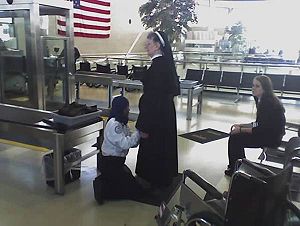
- Image via Wikipedia
Saying something about 9/11 is almost obligatory, especially for a commercial aviation blogger. The scope of the tragedy was nearly unimaginable at the time…that such a thing could happen. Our hearts continue to go out to those who lost loved ones that day and we will never forget the sacrifice of those who rushed to assist.
The two biggest security developments that came in a post-9/11 world were:
- Secure Cockpit Doors
- A change in the policy of crew cooperation with hijackers
Prior to 9/11, flight crews were instructed to cooperate with hijackers. There was no concept that a hijacker might turn an aircraft into a missile and fly it into a populated area, although the idea had been around for years previously. Hijackers took hostages, threatened to kill them unless their demands were met. Now, not only the crew, but the passengers are instructed to forcibly resist and subdue any danger, although this is tempered with some discretion.
The downside was what came out of the charged security environment. We love the idea of the TSA. If you saw some of the people who screened people at airports prior, you applaud the idea that the government should impose some standards on these personnel. But, in the execution, the TSA has been a bit lacking, leading security experts like Bruce Schneier to refer to their actions as ‘security theater’.
Patrick Smith, in his Ask the Pilot series, asked today if we were safer now than we were eight years ago. “What happened in 2001 had nothing to do with box cutters,” Smith says “The hijackers weren’t exploiting lousy security. They were exploiting our mind-set, and our understanding of hijackings at the time.” He believes that the money spent looking for pointy objects, triple-checking people’s IDs, and confiscating harmless liquids should be reallocated to get explosives detection equipment not just at every airport in the U.S., but to foreign airports where passengers should be subject to the same standards on flights heading to the United States.
He believes, and we concur, that the fundamental flaw in the system is that it focuses on rooting out weapons rather than the people who might use them. This also applies to the TSA’s Secure Flight/No Fly Program. Terrorists groups are not stupid, and they devote a large amount of time to observing and planning their attacks. They will find people who will not raise flags to carry out missions. The system as it exists demands we treat everyone as a potential suspect.
Checking for knives, guns, and bombs is not something we should stop doing, but the emphasis on this over more proven techniques is foolishness. Good intelligence has succeeded in nipping a bunch of potential situations in the bud, and more emphasis and training for TSA Agents on behavior pattern recognition over other methods.
We have to spend smartly, and secure smartly. And then, without the blind paranoia that often infects this sort of discussion, we can move forward to efficiently secure our borders.
Related articles by Zemanta
- U.S. to test carry-ons for explosive powders (cnn.com)
- USA requires DOB & gender before you can fly (theglobaltraveller.blogspot.com)
- Rounding out our “love for the TSA” theme (jamesfallows.theatlantic.com)
- Catching Terrorists Not DHS’ Job? (outsidethebeltway.com)
- Fight terrorism by arresting terrorists, not by looking at our genitals at airports (boingboing.net)
- US border station scraps sign that says “United States” because terrorists might attack it (boingboing.net)
- Obama to pick LAX security chief to head TSA (cnn.com)
![Reblog this post [with Zemanta]](http://img.zemanta.com/reblog_c.png?x-id=7f6ca8a9-84c9-4d5b-b9b6-e4c6495a79f1)